AMD Teases Radeon RX 480: Launching June 29th For $199
by Ryan Smith on May 31, 2016 10:00 PM EST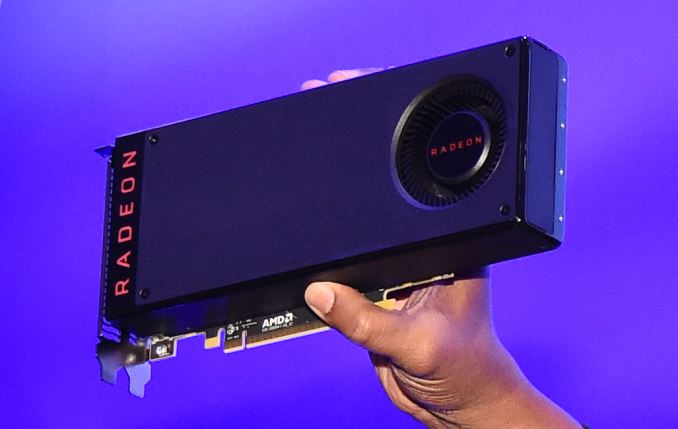
Kicking off at this moment is AMD’s Computex 2016 keynote. The company has multiple announcements scheduled this evening, but we’re going to jump right into an area that has been of extreme interest for many of our readers: GPUs.
Ahead of this evening’s event, AMD sent out an email to the press teasing the first of their discrete Polaris architecture based cards. Called the Radeon RX 480, AMD has unveiled much of the product’s specifications, but also its price and availability. When the card hits the streets on June 29th, it will be starting at the crucial mainstream battleground price point of $199.
| AMD Radeon GPU Specification Comparison | ||||||
| AMD Radeon RX 480 | AMD Radeon R9 390X | AMD Radeon R9 390 | AMD Radeon R9 380 | |||
| Stream Processors | 2304 (36 CUs) |
2816 (44 CUs) |
2560 (40 CUs) |
1792 (28 CUs) |
||
| Texture Units | (Many) | 176 | 160 | 112 | ||
| ROPs | (A Positive Integer) | 64 | 64 | 32 | ||
| TFLOPs (FMA) | >5 TFLOPs | 5.9 TFLOPs | 5.1 TFLOPs | 3.5 TFLOPs | ||
| Boost Clock | >1.08GHz | 1050MHz | 1000MHz | 970MHz | ||
| Memory Clock | 8Gbps GDDR5 | 5Gbps GDDR5 | 5Gbps GDDR5 | 5.5Gbps GDDR5 | ||
| Memory Bus Width | 256-bit | 512-bit | 512-bit | 256-bit | ||
| VRAM | 4GB/8GB | 8GB | 8GB | 2GB | ||
| Transistor Count | ? | 6.2B | 6.2B | 5.0B | ||
| Typical Board Power | 150W | 275W | 275W | 190W | ||
| Manufacturing Process | GloFo 14nm FinFET | TSMC 28nm | TSMC 28nm | TSMC 28nm | ||
| Architecture | GCN 4 | GCN 1.1 | GCN 1.1 | GCN 1.2 | ||
| GPU | Polaris 10? | Hawaii | Hawaii | Tonga | ||
| Launch Date | 06/29/16 | 06/18/15 | 06/18/15 | 06/18/15 | ||
| Launch Price | $199 | $429 | $329 | $199 | ||
First off, the RX 480 will include 36 CUs. If we assume 64 stream processors to a CU – the GCN standard – then this brings us to 2304 SPs. AMD has not named the specific Polaris GPU being used here, but given the CU count I believe it’s reasonable to assume that this is a Polaris 10 SKU, as I’ve already seen Polaris 11 and it’s a very small chip better suited for notebooks.
AMD also revealed that the card would offer over 5 TFLOPs of compute performance. Given what we know about the CU count, this allows us to estimate the GPU clockspeed. This puts the lower bound of the GPU clockspeed at 1.08GHz and an upper bound (6 TFLOPs) at 1.3GHz, which would be in the range of 10-30% higher clocked than comparable Radeon 300 series cards.
In terms of raw numbers this puts the RX 480 just shy of the current Radeon R9 390. However it also doesn’t take into account the fact that one of the major focuses for Polaris will be in improving architectural efficiency. I would certainly expect that even at the lower end of clockspeed estimates, RX 480 could pull ahead of the R9 390, in which case we’re looking at a part that would deliver performance between the R9 390 and R9 390X, with final clockspeeds and architectural efficiency settling just how close to R9 390X the new card gets.
On the memory front the card is equipped with 8Gbps GDDR5, running along a 256-bit memory bus. This is the typical bus width for AMD x80-series cards, and the high clocked 8Gbps GDDR5 means that we’re looking at a total of 256GB/sec of memory bandwidth to feed the RX 480’s GPU. AMD’s partners will be offering both 4GB and 8GB cards, and for the purposes of this teaser I assume that pricing information will be for the 4GB card, with 8GB serving as a premium option.
Finally, AMD has also revealed the TDP for the RX 480, stating that it will be a 150W card. As Polaris is built on 14nm FinFET, we’re seeing first-hand the benefits of finally making the long-awaited jump off of 28nm, as this means we’re looking at Radeon R9 390 series performance in a card that, on paper, consumes only a bit more than half the power. This also puts the RX 480 right in the sweet spot for mainstream cards, as 150W has traditionally struck a good balance between performance and power consumption that allows for a fast card that doesn’t require aggressive cooling, and is more compatible with OEM computer vendor case & cooling designs.
Cementing its place as a mainstream card, the RX 480 pricing will start at $199. This is an aggressive and heavily fought over price point that has traditionally defined the mainstream segment, attracting buyers who want great 1080p gaming performance that sub-$150 value cards can’t offer, without moving up to more expensive (and power hungry) $300+ cards. In this sense the RX 480 is a direct replacement for the R9 380, AMD’s Tonga-based card that hit the market roughly a year ago at the same price. Going by the raw numbers alone, RX 480 would be 40% (or more) faster than the R9 380.
Meanwhile I won’t speculate too much on the competitive market from a teaser, but it’s worth noting that this is nearly half the price of NVIDIA’s currently cheapest Pascal card, the GeForce GTX 1070. Interestingly both cards have the same 150W TDP, but looking at the throughput figures it does not look like RX 480 is meant to offer quite as high performance as NVIDIA’s card.
Moving on, along with teasing the RX 480’s specifications, AMD’s teaser also laid out their marketing plans for the card. We’re previously talked about how both Oculus and Valve/HTC were encouraging developers to treat VR like a fixed platform, and setting minimum hardware specifications to go along with that. On the AMD side those specifications called for a Radeon R9 290, which the RX 480 should be able to beat.
As a result AMD is planning on heavily promoting the VR aspects of the RX 480, as it brings the necessary performance down from a 250W, $300+ card to a 150W, $200 card. In fact AMD is claiming that VR performance will be closer to $500 video cards, in which case we’d be looking at performance closer to the Radeon R9 Nano, a Fiji based card.
With all of that said, the video card is just one component in the total price of a VR system – you still need the headset – but on the PC side it has also been the most expensive component. Consequently, AMD sees cheaper video cards that offer good VR performance as being important to bringing down the total price of a VR-ready system, and will be promoting the RX 480 as the prescription for entry-level VR needs. From a business perspective, AMD is ultimately expecting VR to be a fast-growing market, so the company wants to make sure they don’t miss out and have more VR-capable cards on the market as quickly as they can.
Along those lines, AMD’s release also makes note that at least one model will be “both HTC Vive Ready and Oculus Rift certified,” though no further details are being offered at this time. Whether this is just a certification matter or if there’s going to be something special about this model (e.g. connectors) is open to speculation.
Finally, now that they’ve revealed the price and much of the specifications of their first Polaris card, AMD is also releasing more details on their overall development and market positioning strategy with Polaris. As AMD has hinted at in the past, Polaris is being specifically developed for and aimed at the mainstream market. AMD wants to recapture lost market share – especially in laptops – and the large mainstream market is seen as the best way to do that. AMD is calling this their “water drop” strategy, and I expect we’ll hear a bit more about it tonight, including the meaning behind the name.
And with all of that said, it looks like we’re going to have a lot of AMD to talk about on June 29th. So until they, stay tuned.
Above: AMD SVP & Chief Architect Raja Koduri, Who Is Very Happy That Polaris Is About To Launch


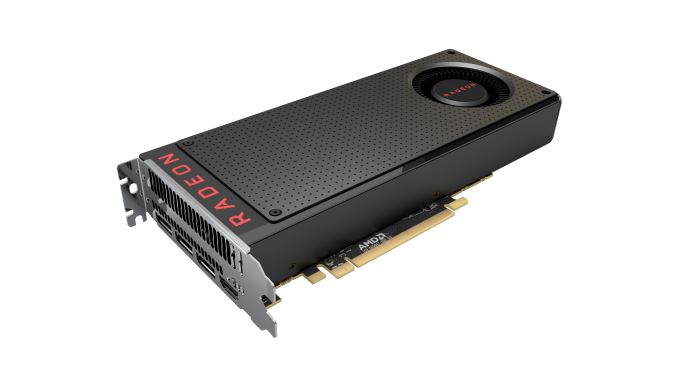

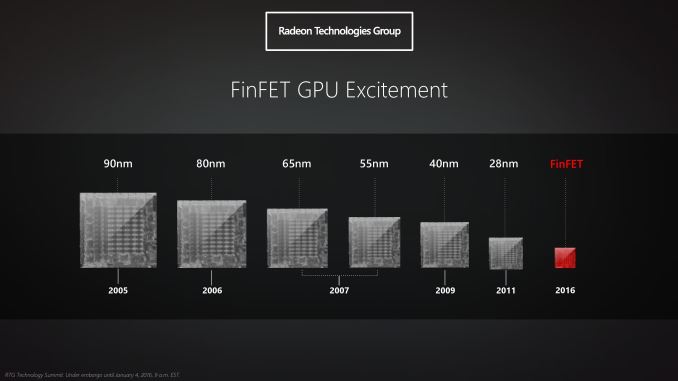
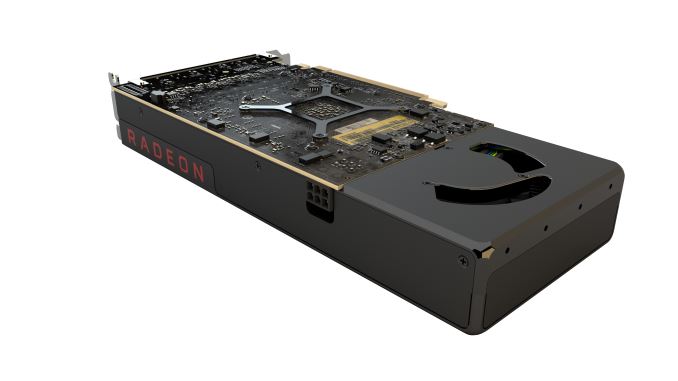




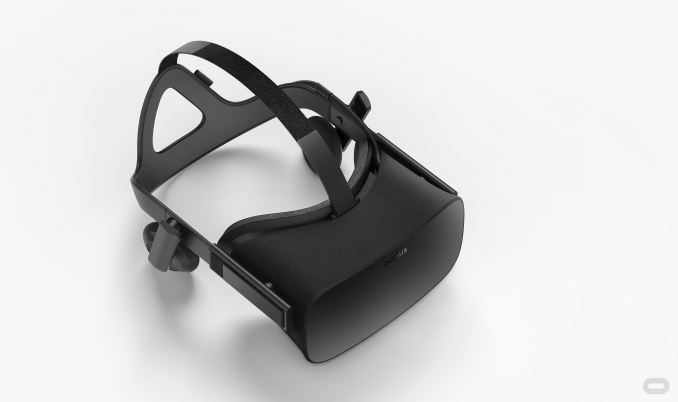









377 Comments
View All Comments
D. Lister - Wednesday, June 1, 2016 - link
@atlantico:)
Nvidia's current market share and stock position suggest you may have to wait a bit for those good times. Don't lose hope though, it could very well happen in your lifetime.
tamalero - Wednesday, June 1, 2016 - link
There is a huge difference in a "nvidiot" (aka someone who defends the company even if they fist them so hard on the butt) to "educated gamers". educated gamers have no brand and switch whatever brand gives better perf for the money with less problems.The ball is on Nvidia's side right now.
Enigmatica - Thursday, June 2, 2016 - link
Especially on the higher-end market. I have a 144Hz 1440p IPS G-sync monitor (best thing I ever did to improve my gaming experience) and the only card I can see getting close to pushing my monitor on demanding games is the 1080, or even the 1080ti if I am patient enoughHammerStrike - Wednesday, June 1, 2016 - link
Since competition has no bearing on price, I'd like to offer you my services at no charge. Simply agree to route all your online purchases through me and I guarantee that I get you the absolute best price while dealing with all the order entry, tracking, etc. Win-Win.D. Lister - Wednesday, June 1, 2016 - link
@HammerStrikelol, it seems your analogy got out of your hands there. Mainly because it was based on a false premise. No worries, keep trying. *thumbs up*
JKay6969AT - Thursday, June 2, 2016 - link
If there was no AMD we wouldn't be talking about the 1080 or 1070 as they wouldn't likely exist. Market stagnation and rising prices WOULD BE and ARE a result of a monopoly.Just look at the prices of intel's high end offerings, they have been steadily rising and the benefits seen between generations are incremental at best. They are milking the market with high prices and less innovation, why not AMD doesn't currently have anything on the market to compete beyond the Core i5 have they? This is not a knock on AMD simply a fact of the market.
With Zen and Vega AMD look set to return to the high end in both CPU and GPU. This is a good thing for all. No one is saying you have to buy either but that intel and nVidia will be forced to up their game by dropping prices and increasing innovation. It's a win win for all.
D. Lister - Thursday, June 2, 2016 - link
"If there was no AMD we wouldn't be talking about the 1080 or 1070 as they wouldn't likely exist."Nvidia (or Intel, for that matter) doesn't make their products just to be in some sort of a technological pissing contest with AMD. Companies cater to the needs of the market. If there is demand for more power, then there is money in making more powerful hardware. Sure, without a race, the technology may grow slower, but that means software developers would have more time to optimize for every arch (a la consoles), which means that at the end of the day, we as consumers, would see the same growth in graphic quality, but only with lesser bugs.
"Just look at the prices of intel's high end offerings, they have been steadily rising and the benefits seen between generations are incremental at best."
Read through the following links:
http://smallbusiness.chron.com/inflation-effect-pu...
http://phys.org/news/2015-08-silicon-limits-power-...
fanofanand - Thursday, June 2, 2016 - link
You are SO right, it's not like Intel with it's dominant monopolistic position on the high end just increased their price for their top CPU by 80% or anything. Oh wait.....Chaser - Wednesday, June 1, 2016 - link
The GTX 1070 is $379.00 and offers Titan X/980Ti performance. So in this case please tell us all which AMD product forced Nvidia to offer a less expensive, more powerful, more efficient product this round?pashhtk27 - Wednesday, June 1, 2016 - link
Well, last round AMD forced Nvidia to release gtx980ti. You were not gonna get gtx980ti which performs close to titan without Fury X coming out. I reckon it'll repeat next year with 1080ti........They had no competition this round so they increased the prices of gtx1080 and gtx1070 by 'a small amount'. Monopoly doesn't come in a day, nor does it mean that prices rise up suddenly like inflation. Nvidia can offer a lot more with competition. Now they will be forced to unveil a good gtx1060 which might not have come had there been no rx480 in my opinion.
Talk about Intel....just check the prices of i7-6950x.......
Competition in the mass market segment is very important. Look at the difference between gtx950, gtx960 and gtx970. It made everyone recommend the later over former two cards for mid-level segment. I remember a few years ago the most common recommendation was gtx560ti, gtx660ti for the same. This is how you play market games.